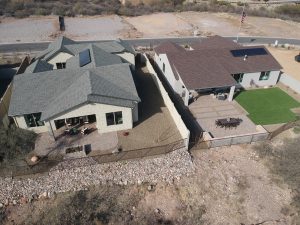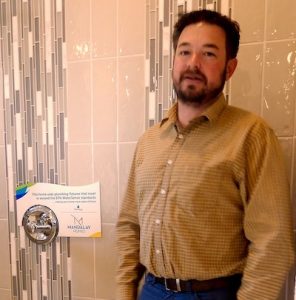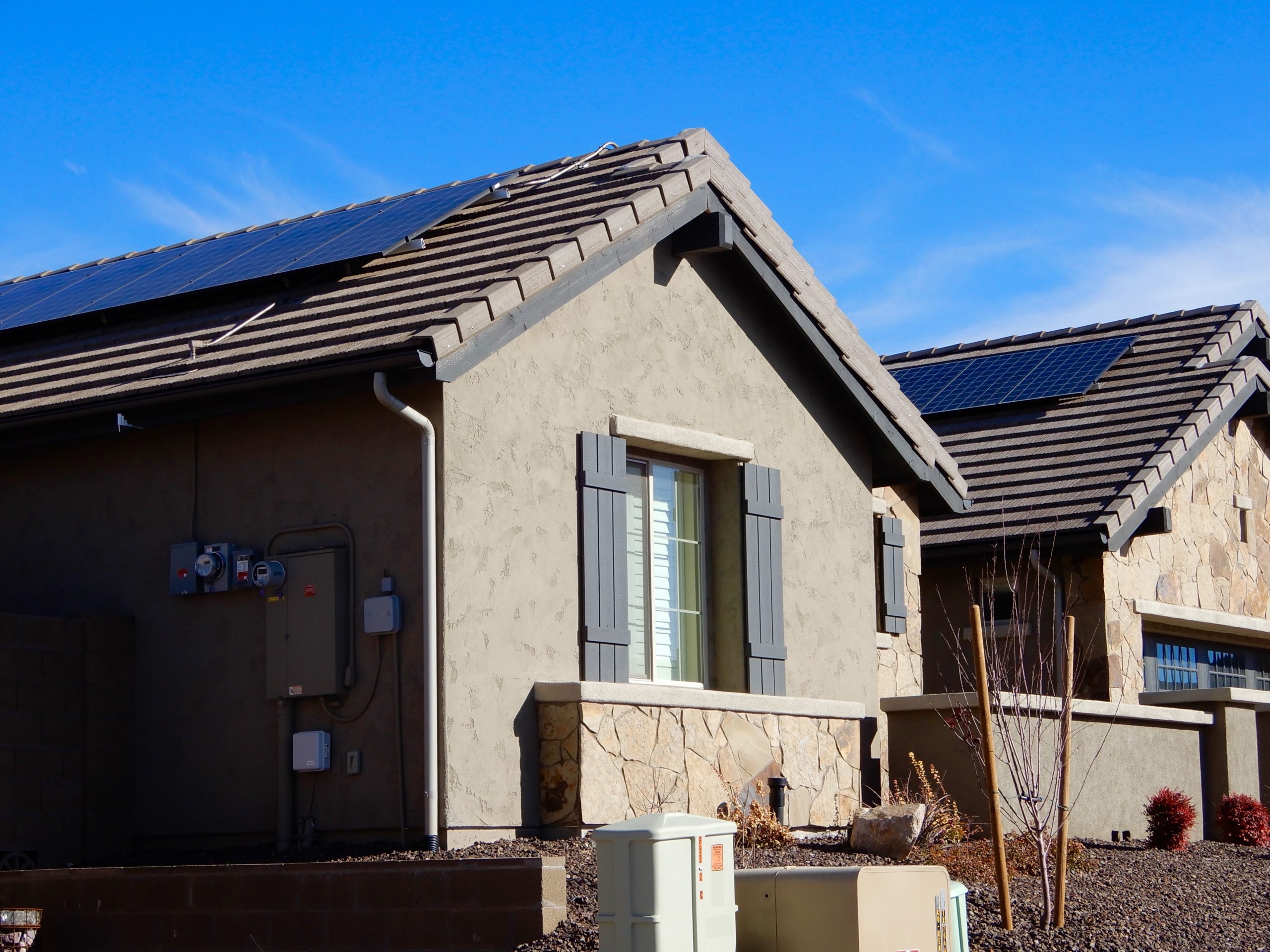Mandalay Homes, based in Arizona, recently introduced the iON Series, a set of smart energy features that includes an extremely tight, well-insulated building shell, high-efficiency heating and cooling system, and on-site solar with battery storage. “In the past, we have guaranteed four things in our energy-efficiency package,” says Geoff Ferrell, “Our homes achieve a Home Energy (HERS) Index
of 50 or less along with three third-party certifications: Indoor Air Quality Plus, ENERGY STAR and Zero Energy Ready Home. With the iON Series we have increased our commitment to clean energy and improved value to the customers.”
Starting with a foundation of its low HERS rating and its three third-party certifications, the iON Series integrates optimized energy collection, storage, and management to build zero energy homes in a way that supports grid integrity.
The Duck Curve: a Threat to Grid Integrity and the Future of Zero Energy Homes
Arizona’s utilities and homeowners have invested heavily in grid-connected solar resources – enough to create an imbalance between electricity demand and supply. This so-called “duck curve” results because daily peak demand occurs in the late afternoon and evening when most people return home and crank up the air-conditioner. However, peak energy production from solar electric panels occurs closer to midday. Traditionally, the electric grid has been unable to store the excess electricity from renewable sources for when it’s needed most.
This imbalance has been used by some grid operators to threaten the future of grid-tied, net-metered, zero energy homes. Some utilities may attempt to solve the duck curve challenge by creating rate structures and interconnection requirements that make net metering disadvantageous to zero energy home owners. Several obvious solutions to the duck curve fall to grid operators themselves, including developing battery storage, pumped hydro, microgrids, time-of-use rates and demand management. While some of these solutions will take time and money to implement, time-of-use rates and demand management are low cost and easy-to-implement strategies which require builder participation.
An Elegant Solution to the Duck Curve
Mandalay Homes and Arizona Public Service (APS) have partnered to address this issue at the neighborhood level. Every Mandalay home in their three newest communities will include the all-electric iON Series features: a HERS Index of around 30 which includes the addition of a six-panel (2 kW) solar array, and a 10 kW Sonnen Eco 10 energy storage system. Beyond just a battery, the Sonnen system can be programmed for a number of intelligent energy management functions, including grid-integration in a way that helps eliminate the duck curve.

The all new iON Series from Mandalay Homes is grid friendly, thanks to a small solar electric array and on-site battery. Photo: Bruce Sullivan
APS has introduced an innovative time-of-use and demand management strategy and works with Mandalay homes to implement it. As a part of their Mandalay home purchase contract, buyers agree to an APS rate program that charges them only 4.75¢ per kWh for all their purchased electricity during off-peak times – a much lower rate than the national average of around 12¢ per kWh. The vast majority of this energy comes through APS from renewable sources such as wind and solar. The catch is that customers may not use grid electricity during the peak demand hours of 3 to 8 pm. This is where the Sonnen battery system comes in. It stores enough electricity to keep everything running – all the space heating, cooling, water heating, lights, and appliances – during these hours when the home is not drawing power from the grid.
Solar energy from the 2 kW array is used primarily to charge the batteries. The Sonnen system also locks out grid power from 3 to 8 pm. Because the home’s high-performance envelope and high-efficiency equipment keeps energy use so low, energy stored in the relatively small on-site battery is sufficient for this period.
Ferrell projects that homeowners in these communities will spend as little as $12 per month for energy, plus about $18 per month for the standard APS service charge and taxes. While some observers may not see these as true zero energy homes, the electricity supplied via the APS grid is clean and renewable. This hybrid approach offers an extremely cost-effective path that is beneficial for the electric utility, affordable for homebuyers, and profitable for the builder.
This type of partnership between Mandalay and APS based on APS’s new electricity rate schedule is available to others in APS territory. It would be great to see other developers and builders follow Mandalay’s example to benefit both utilities and consumers. The Mandalay APS approach may well become a model for use in other utility service areas where there is high solar production and the duck curve is becoming a threat to the expansion of net-metered, grid-tied, solar-powered homes.
Performance Optimized Buildings are the Starting Point
“Before we can go with solar and batteries, we need to optimize the home,” says Ferrell. Mandalay’s standard approach is based on climate-appropriate building science. Over the course of several years, Mandalay has evolved a long list of high-performance energy features culminating in the new iON Series with a HERS Index of 50 or less before the application of solar. This level of performance puts the home firmly in the zero energy ready category where affordable renewable energy can be added to supply all the energy needed by the home.
To achieve this rating, Mandalay uses a set of proven energy-efficiency features:
- Spray foam insulation: Walls cavities are filled with open-cell spray foam. While the insulating value is about the same as fiberglass batt insulation, foam does a far better job of filling all the nooks and crannies that batt insulation can leave open.
- Conditioned attic: Open-cell spray foam is also applied to the underside of the roof sheathing. This brings the entire attic into the building’s conditioned envelope.
- Ducts inside: The entire heating and cooling system resides inside the conditioned envelope. In single-story plans, the furnace and ducts run through the conditioned attic space created by insulating the roof sheathing with spray foam. In two-story plans, additional ductwork for the first level runs through the intermediate floor that is framed with open web floor trusses.
- Slab-edge Insulation: High-density (3.0 lbs/cu. ft.), closed-cell spray foam insulation covers the edge of the slab-on-grade foundation both above and below grade. Because the 3-pound foam is so strong and durable, the portion exposed above grade can simply be painted, with no need for additional protection from sunlight or physical damage.
- Aerobarrier: The newest addition to Mandalay’s energy suite is a new air sealing system that is relatively inexpensive, highly effective, and consistent. Aerobarrier injects an airborne aerosol mist into the building as it is being pressurized with a blower door. The mist-laden air pushes out of the building through cracks and openings. The aerosol sealant accumulates and eventually fills the openings. The process takes about 4 hours per house. Installers monitor progress and stop when the home reaches the desired level of air tightness. Mandalay homes now average 0.7 air changes per hour (ACH50).
- Ventilation: Highly consistent air tightness allows mechanical equipment to be sized properly. Energy recovery ventilators are selected to deliver the appropriate amount of whole-house ventilation, while quiet bath fans and range hoods provide spot ventilation.
- Equipment sizing: Heat pump capacity is reduced with confidence that occupant comfort will not suffer on extreme days. Mandalay saves roughly $800 per home through optimization and a heat pump that is ½ ton smaller.
Consistency in the Construction Process
Production builders strive for consistency and save money by shaving expenses wherever possible. To this end, Mandalay created an in-house Performance Team. These two employees have three jobs: installing the high-density spray foam slab-edge insulation, implementing the Aerobarrier sealing equipment, and mounting solar panels on the roof. Mandalay saves money by bringing these specialized tasks in-house rather than hiring outside contractors.

Mandalay Homes’ Geoff Ferrell
Mandalay Homes has positioned themselves in the northern Arizona housing market as the builder who delivers value and creative solutions to systemic problems. Mandalay’s marketing messages emphasize consistently lower electricity bills and the greater buying power it brings. Ferrell sums it up this way, “As production builders, our approach has been to offer the fundamentals: affordable price point, good designs, great communities, and then add superior energy performance to crush the competition.” Most importantly, Mandalay homes, in conjunction with APS, have created an elegant path forward for grid-friendly solar powered zero energy homes.


2 thoughts on “Mandalay Homes: Zero Energy Grid-Integrated Neighborhoods that Solve the “Duck Curve””